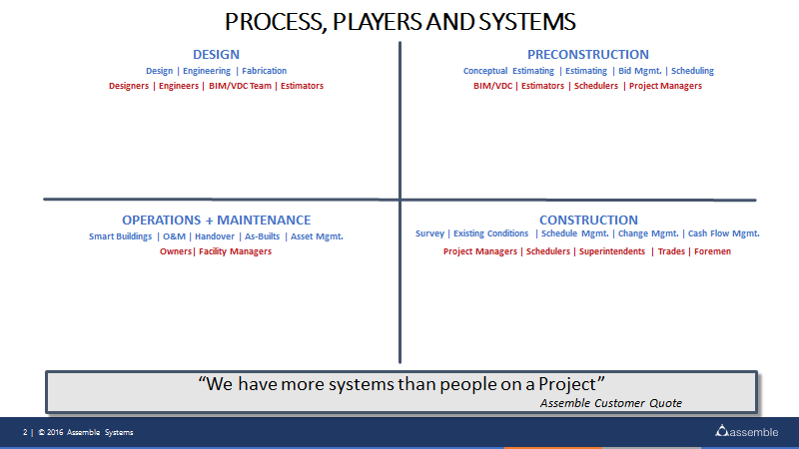What it takes to win today is different from 10 years ago and tech savvy construction personnel are beginning to differentiate their firms from their competitors through the use of a construction software stack. Let’s define the stack as a set of applications that a construction project team uses to help them do their job. Here are three techniques you can implement in 2017 that will help you define, leverage, and promote the use of the “stack” on your projects.
One, make this an initiative for yourself and your team. This includes both colleagues that you work with as well as the leadership team that you report to. For example, if your role is VDC Manager you want to include the colleagues who benefit from your work, such as the Estimators and Project Engineers who will use the models and associated metadata to assist them in their work creating estimates, bid packages, schedules, and look-aheads. You also want to sit down with the Manager or Director whom you report to and together define several objectives for the use of this stack within your construction management processes. As an example three high level goals could be:
- Use models on every new construction project. Define the different use cases and make sure the team uses the available model for at least one use case per project.
- Hold a monthly “Lunch and Learn” session that promotes learning so that project teams in your region know the kind of information and use cases that BIM can be used to improve project performance. Another presentation could be a lessons learned session. Here you ask a project member that has used BIM on one of the company’s projects to report back where they used BIM, how it helped, and any other feedback they can give. All the feedback does not have to be positive as change is not typically easy. This could also be a problem solving session.
- Create an incentive of some kind for teams that use BIM on projects and push the learning out into the field. An incentive could be an award for the best “stacked” project each quarter or it could be a barbeque for the project team and subs who collaborated together with the team.
These are only a few examples of objectives to foster Virtual Design and Construction Process Improvement in your firm. There are many more that you could create; or you might find that your CEO and his team have a goal for the company that is consistent with expanding the use of your stack, models, and their metadata throughout the company.
Two, collaborate with others including your key subcontractors and local organizations who are promoting the advancement of the AEC industry. From the AIA and ABC to the AGC and all the acronyms in between there are many trade organizations that hold regional meetings to discuss the use of Building Information Modeling as well as Virtual Design and Construction solutions for all types of applications and projects. Getting involved with these organizations will help you to learn more and meet like-minded people in your region. Many subcontractors use 3D effectively and there are things you could learn from each other. There are also some subcontractors who perform work such as water proofing that could benefit from access to your visual BIM data. For more on this read this blog post Get out there and learn.
Three, define your construction technology stack. There are probably three main categories and multiple subcategories to consider. You might start by dividing your software into a diagram that could be called “The Process and the Players.” One way to build a representation of this could be to use the following diagram and spend an hour with your team to fill in the different quadrants.
Once you have built your diagram start to think about how you could better automate the sharing of data across the stages of your projects. I’ll have more to say on that soon.
Do n Henrich is an accomplished technology veteran in both the MCAD and the AEC industries. As Chief Operating Officer of Assemble he is responsible for strategic vision, sales, marketing, customer support, partners, and field operations. Don and his wife Noel have three children, reside in Marblehead, MA and spend as much time as possible sailing on Massachusetts Bay.
n Henrich is an accomplished technology veteran in both the MCAD and the AEC industries. As Chief Operating Officer of Assemble he is responsible for strategic vision, sales, marketing, customer support, partners, and field operations. Don and his wife Noel have three children, reside in Marblehead, MA and spend as much time as possible sailing on Massachusetts Bay.
If you enjoyed this post, please help it spread by emailing it to a friend, or sharing it on Twitter or LinkedIn.



Comments are closed.